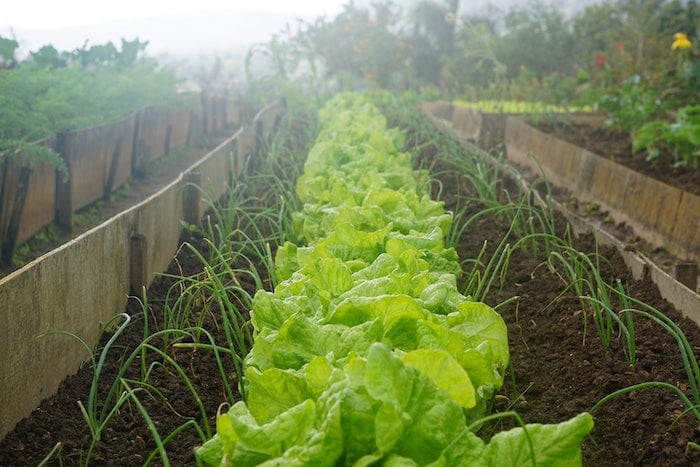GardenAdvice guide to growing fruit and vegetables

The basics to growing your own Fruit and Vegetables
The site for growing fruit and vegetables – it has to be a location in full sun and not shaded. Try to grow fruit and vegetables in shade will not work.
Composting – it is worth installing a compost heap at the start so you can recycle all the old compost and vegetables etc. We do not recommend using cooked kitchen scraps because of problems with rats and mice. Composting uncook vegetables are OK
The best compost heap are created from old building pallets using tree stakes to hold up the sides
The three keys with compost are, 1. a. handful of Growmore fertilizer for every layer of compost you create 150mm high, 2. keep the compost heap moist. Water in the summer, keep the compost so squeezing a handful will produce two or three drops of water. 3. Keep the compost warm in winter by covering it with old carpets. These three items will keep the bacteria working all year round to quickly produce usable compost.
It is also worth adding some red composting worms to the compost heap ( not the common lobworms found in your garden )
Irrigation – it’s worth installing some drip irrigations this can be drip pipes or leaky pipes. Irrigation can run off the mains water or from water collected into water butts with water from your roofs. The water butts need to be held up on bricks to create a gravity feed irrigation system with a timer.We have shown that a simple irrigation system will increase your crops by a third
Soil – for a raised bed or soil in your beds ideally it needs to be a loam. Loam is the soil that is just below the surface of a lawn or grassland area it contains lots of organic matter and worms and it is the best soil
for growing fruit and vegetables. Normally especially with raised beds, people tend to buy soil that’s too sandy or destructured so adding some well-rotted manure, spent mushroom compost or Coconut Coir Compost. If you have sandy soil adding some chicken pellet manure can also help.
Fertilizers – with fertilizers we recommend using a handful per square metre of Growmore fertilizer which is balanced and does not over fertilizer the soil. Best applied in winter, then in the summer, you can follow up with some liquid tomato feeds which contains lots of potash.
Special soil conditions – Asparagus is a plant that’s family grows on the seashore so needs a light application of salt to the soil surface in the winter. Cabbage and other brassica family plants need an application of garden lime to slightly raise the soil pH and supply the additional nitrates needed for growing brassicas
Lobworms – adding lobworms to your fruit and vegetable area is a good idea as they improve the soil structure quickly with the addition of spent mushroom compost or other organic and matter.
If the soil you are using to grow fruit and vegetables does not support Lobworms then you need to add more organic matter to improve the soil structure.
Seeds and Young plants – ideally you need to use a combination of seeds and young plants. With seed, it’s important to purchase from a commercial seed merchant if possible as you will get better quality seeds.
https://www.wholesale.molesseeds.co.uk
With young plants, it’s important to order well in advance before Xmas ideally
Protection for early season crops
Its possible to sow and grow early season crops with cold frames and garden cloches which can simply be placed over the your seeds or young plants to get them to develop faster in the early season. Another good method to produce early season crops is to place black plastic on the soil in January to collect the suns rays to warm the soil before you plant out your young plants or sow your seeds.
Pest control
Barrier – for flying pests ranging from aphids to pigeons one of the best pest control methods is to use a mesh barrier which is a fine net material that physically stops pests. It’s particularly useful with carrot root fly that finds your carrots by the scent they produce when the stems are broken.
Slugs – the worst pest in a vegetable garden, for controlling larger slugs you can use simple beer traps and for general control of slugs, slug nematodes are the best method. Slug nematodes are a small worm that is watered onto the soil and attacks the slugs killing them. Before application, it’s best to water the soil as they travel in the soil water.
Another often forgotten method of slug control is to use upturned clay pots to support toads which in turn will eat your slugs.
Softsoap – this is an organic spray made from soap that can be used on such pests as blackflies.
Companion planting – has two purposes one to host beneficial insects such as ladybirds and lacewings both eating aphids.
In addition companion planting with a few marigolds and calendula helps mask your crops with a visual effect and scent.
Catch crops – are simply a crop that is planted or sown alongside other long term crops such as potatoes and mature quickly before the main crop is ready using the space alongside the main crop. A good example is rocket and salad leaves.
Early season Hotbeds – it’s possible to grow early season crops using the heat generated from fresh manure in the winter to force or grow out of season crops such as strawberries and lettuce.
Planting in flower beds – Vegetables especially early season crops such as peas can be grown in your existing plants in your flower borders. For example, peas and chard leaves can be sown from seed in your borders early season with garden bell cloches. The plastic garden bell cloches are cheaper than the glass ones. Both are reusable.